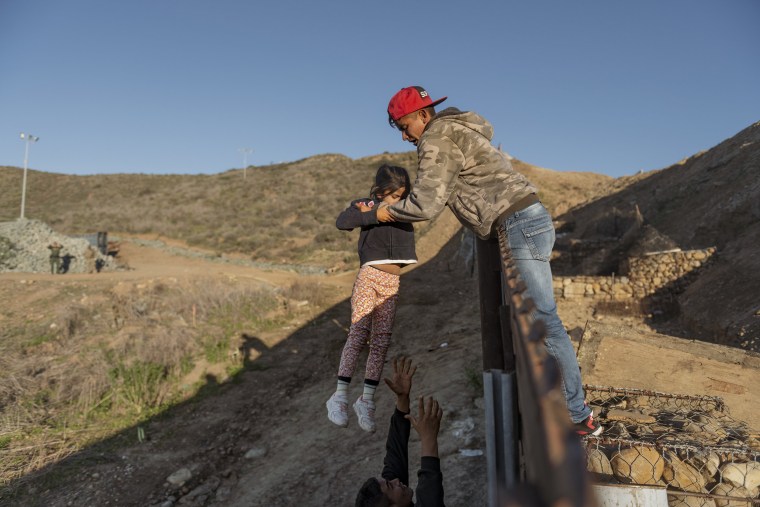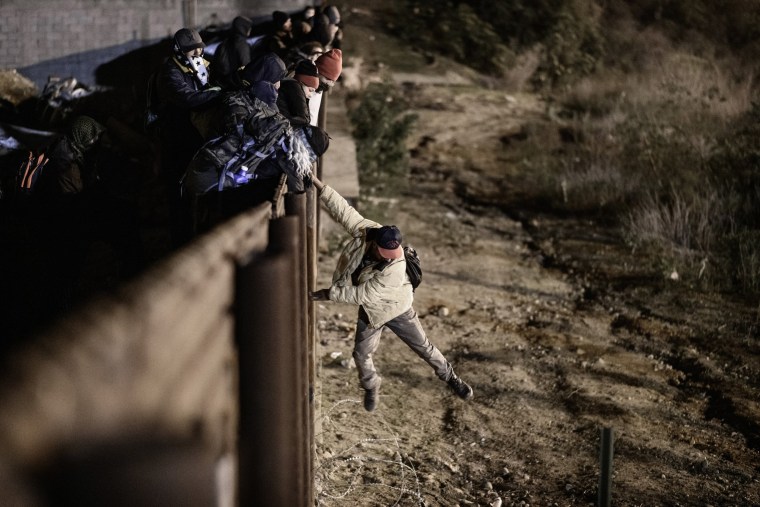When President Trump argues that the United States needs a wall along the southern border, he likes to point to San Diego's success.
There, double and triple barriers fortify the westernmost stretch of the nearly 2,000-mile U.S.-Mexico border as U.S. Border Patrol agents drive SUVs along frontage roads and hover overhead in helicopters.
The militarized border touching the communities of Imperial Beach, San Ysidro and Otay Mesa contributed to a 75 percent decline in crossings in the years immediately after fencing was installed in the 1990s, according to U.S. Customs and Border Protection data.
The decline mirrors a border-wide decrease.Apprehensions of those suspected of illegally crossing the entire Southwest border experienced an uptick in 2018 over 2017 to nearly 467,000 but remained at less than half their peak in the 1980s and 1990s, when the Border Patrol racked up 1 to 1.6 million apprehensions.
President Donald Trump, who's in a protracted battle to secure congressional funding for his campaign promise to build a wall along the entire length of the Southern border, on Thursday pointed to San Diego's Mexican neighbor, Tijuana, as an example of what can happen with and without a barrier.
Trump's proposed wall, based on one of eight prototypes in San Diego, is yet to be authorized by Congress.
"If you go to Tijuana and you take down that wall, you will have so many people coming into our country that Nancy Pelosi will be begging for a wall," he said from the Oval Office. "She will be begging for a wall. She will say, 'Mr. President, please, please give us a wall.'"
While it seems unlikely the House speaker would ever beg for a wall, the president has a valid point about fencing's impact on the border region. Although San Diego's barrier may stem illegal crossings, its impact is more complicated than Trump's statement that "walls work" suggests.
From the 1980s to the early 1990s the Border Patrol's San Diego sector was overrun with people illegally crossing the border. Hundreds of migrants would gather on a Tijuana River levee known as "El Bordo" and, much like the climactic border crossing scene in 1987's "Born in East L.A.," rush the few Border Patrol agents brave enough to try to stop them.
In the 1980s, about 40 percent of the Southwest's illegal border crossings took place at San Diego, said Victor Clark-Alfaro of San Diego State University's Center for Latin American Studies. The peak year for border apprehensions in the San Diego sector was 1986, when 628,000 migrants were nabbed.
"Tijuana was like a fiesta," Clark-Alfaro said. "On a single day on a weekend at El Bordo you could find about 1,000 migrants ready to cross to the U.S. side. There was liquor, marijuana, human smugglers, street vendors."
The defunct bureaucracy known as the U.S. Immigration and Naturalization Service, since replaced by three agencies under the Department of Homeland Security, built fencing along the border at San Diego in 1990, but it was no match for desperate Mexicans.
The migrants created a huge wave of south-of-the-border crossings into the U.S. that was addressed by Republican Pete Wilson, a onetime San Diego mayor who won re-election as California governor in 1994 based on a Trump-like platform of deterring illegal immigration.
"Bill Clinton had to respond," said David Shirk, director of the University of San Diego's master's program in international relations.
In 1994, President Bill Clinton initiated Operation Gatekeeper, a crackdown at the border, and Congress followed up two years later with 14 miles of "triple-layered fence," according to congressional records. Some of those first fences were made from Vietnam War-era landing mats intended for makeshift helicopter airstrips.
In 2006, Congress authorized "double-layered fencing" along at least 700 miles of border. The full length has yet to be covered with fencing because of delays in acquiring private property, often through court battles. But the San Diego sector received fresh fencing in the mid-1990s and again in the late-2000s.
Experts, many critical of Trump's overall stand on border security, acknowledge the San Diego barriers, now made of steel bollards and surplus military landing mats, have more or less done their job. The sector went from being the top location for border crossings to a relative ghost town with 26,086 apprehensions in fiscal year 2017, according to the Border Patrol.

The hardened border, however, pushed migrants to remote areas that have few man-made impediments and are often just World War II-style vehicle barriers known as Normandy fencing, Clark-Alfaro said. Arizona has become a hotbed of crossings, but migrants often die of dehydration. The mountains east of San Diego have also become a crossing zone, where migrants have died from hypothermia.
Some migrants head for the cold Pacific and end up dead or arrested.
"Our beach was invaded by people on pangas, boogie boards," said Imperial Beach Mayor Serge Dedina, adding that the fortified fencing "didn’t stop the tunnels" used by cartels to ship drugs into California and beyond.
The San Diego-area border security measures have also enticed cartels to dive deeper into smuggling because the barriers drive up prices for guides or coyotes, experts say. Prices have gone from as little as $75 in the 1990s to as much as $7,000 today, said San Diego State's Clark-Alfaro.
"We’ve made it more profitable for human traffickers along the border," added Shirk, of the University of San Diego.
However, narcotics continue to make it across the Southwest border, with seizures of heroin in the San Diego sector increasing 59 percent from 2016 to 2017, according to the U.S. Drug Enforcement Administration.
The San Diego sector was the top target along the southwest border for heroin smuggling outside points of entry, the DEA said. Eighty-five percent of the synthetic opioid fentanyl that crossed in 2017 entered through the San Diego area, according to DEA data.
Experts argue that one of the biggest influences on border crossings has been the Mexican economy, which has improved enough that many workers would rather just stay home. In Tijuana, home to a booming appliance and TV manufacturing sector, thousands of jobs are up for grabs.
And many of the immigrants from that huge wave in the 1980s and 1990s settled in the United States rather than crossing back and forth for seasonal work, experts say. In effect, they were walled in by the increased border security and are now staying put.
The boosted federal presence along the border also includes an exponential increase in the number of Border Patrol agents since 1990 to more than 20,000 today. At least 85 percent are stationed along the border, according to Shirk's research.
Much of that increase in personnel came in the years following 9/11, when the Department of Homeland Security was created and crossing the border legitimately became much less casual, Shirk said. Passports are now required for travel in both directions.
The new border-crossing population comes mostly from Central America, where migrants have formed caravans to travel north. People fleeing murderous gangs — some, like MS-13, were born in the U.S. — have mostly sought asylum in the United States legally, although the Border Patrol U.S. Customs and Border Protection says groups of Central Americans have recently tried to rush into the country illegally.
The bottom line on San Diego's beefed up border, some of which is slated for replacement, is a mixed bag effective at deterring crowds of migrants that will ultimately be undeterred.
"It's effective at re-routing people," said John Fanestil, a Methodist minister who has offered communion on the United States side of the fence. "We made it harder to cross the border illegally — more deadly, more costly. But when circumstances are as extreme as they are in Central America, people will demonstrate great determination to cross the border."


